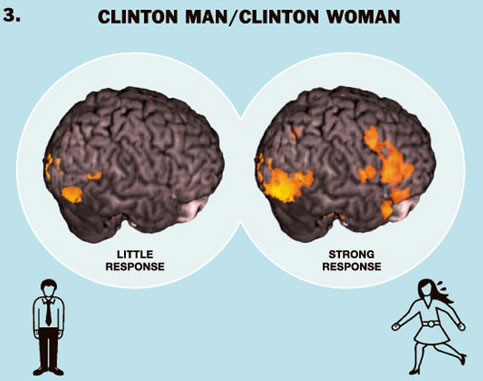Political Neuromarketing

I’ve been waiting for the first news of neuromarketing in the 2008 U.S. presidential election, and it has arrived a full year before the election itself. The first few conclusions seem so obvious as to not require firing up a multi-millon dollar fMRI machine:
- Voters sense both peril and promise in party brands.
- Emotions about Hillary Clinton are mixed.
- Hillary Clinton and Rudy Giuliani are on opposite sides of the gender divide.
These were among eight conclusions of a brain scan study described in an New York Times Op-Ed piece, This Is Your Brain on Politics, credited to Marco Iacoboni, Joshua Freedman and Jonas Kaplan of the University of California, Los Angeles, Semel Institute for Neuroscience; Kathleen Hall Jamieson of the Annenberg Public Policy Center at the University of Pennsylvania; and Tom Freedman, Bill Knapp and Kathryn Fitzgerald of FKF Applied Research. The details involved in reaching each conclusion may be more interesting than the seemingly bland summaries. Here’s the Hillary Clinton one, for example:
Emotions about Hillary Clinton are mixed. Voters who rated Mrs. Clinton unfavorably on their questionnaire appeared not entirely comfortable with their assessment. When viewing images of her, these voters exhibited significant activity in the anterior cingulate cortex, an emotional center of the brain that is aroused when a person feels compelled to act in two different ways but must choose one. It looked as if they were battling unacknowledged impulses to like Mrs. Clinton.
Subjects who rated her more favorably, in contrast, showed very little activity in this brain area when they viewed pictures of her.
This phenomenon, not found for any other candidate, suggests that Mrs. Clinton may be able to gather support from some swing voters who oppose her if she manages to soften their negative responses to her. But she may be vulnerable to attacks that seek to reinforce those negative associations.
Web favorite Ron Paul was absent from the article. The researchers concluded that Barack Obama still has some work to do:
Mr. Obama was rated relatively high on the pre-scan questionnaire, yet both men and women exhibited less brain activity while viewing the pre-video set of still pictures of Mr. Obama than they did while looking at any of the other candidates. Among the male subjects, the video of Mr. Obama provoked increased activity in some regions of the brain associated with positive feeling, but in women it elicited little change.
Our findings suggest that Mr. Obama has yet to create an impression on some swing voters. While his speech resonated with the men in our study, it failed to engage the women. Since we did our scans, Mr. Obama has altered his tone somewhat, and it will be interesting to see if that makes a difference.
These, and the other points, are all interesting and somewhat logical. Still, this is the kind of result that’s hard to prove or disprove. While a general comparison of this type may be good for publicity, a more useful study would be an in-depth comparison of one candidate’s talking points, or perhaps campaign ads. This might provide some useful direction to a campaign trying to decide, for example, whether to take a softer approach or be more hard-line.
And, of course, as the campaign gets past the primaries, the sole group likely to be of much interest to both conventional pollsters and neuromarketers is the independent or uncommitted category. Conventional wisdom in political campaigns is that you don’t waste time and money trying to convince members of the opposing party. That practice is confirmed by brain scans, which have shown that rational analysis has little impact when campaign ads are viewed, and messages unfavorable to the viewer’s positions are discounted or ignored.
See also:
Clinton vs. Obama, Microsoft vs. Apple
Why Negative Ads Work: Framing, Emotions, and Irrational Decisions
The Neuroscience of Political Marketing
